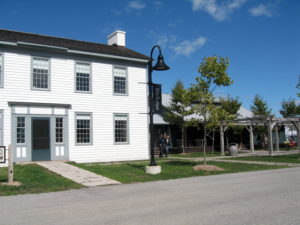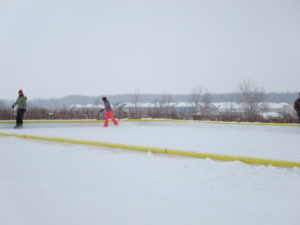 Ravine Vineyard Estate Winery has always been one of my favourite spots.
Ravine Vineyard Estate Winery has always been one of my favourite spots.
There are a number of things that make Ravine special – the wines are lovely, they have one of the best restaurants in the area, and it’s a family-friendly place.

What I think a lot of visitors don’t know is that the house at Ravine has an especially interesting history. Though I knew the unusual history of the building, when I was there earlier in February, I thought it would be interesting to ask some of the staff about it. To my delight, Sally, one of the retail associates was happy to tell us about it. She was so knowledgeable, I asked her if she would let me shoot a short video of her telling us the story. She kindly agreed and you can watch the video here.
After I got back, I decided to dig up my original description of Ravine – the one that was included in the app back in 2012. My description of the winery is still on point, so I thought I’d re-publish it here – for those who might not have seen it:
Tucked Away Gem
I had never heard much about Ravine Vineyards and had really never even driven past it. So, when I went looking for it, I knew I’d be surprised. Turns out I was surprised and charmed. There’s something about the clean lines and symmetric look of the restored historic Georgian home that appeals to my aesthetic sense. Then, when I noticed what looked like food being served on the charming patio, I was more than intrigued. (More on the surprises about the food in a minute.)
Walking into the house you step back into history. The home is lovingly maintained and information is thoughtfully on hand for folks like me who didn’t know of the rich – and unusual – history of the unusual home. Though I knew a bit about the history of Niagara-on-the-Lake, I had never heard of the Wm. Woodruff House – the house that replaced the original 1802 house of David Secord that used to stand on the property before being almost totally destroyed (the original fireplace and chimney from the original house still exist) by the Americans toward the end of the War of 1812.
But the history of the home does not end with its being rebuilt after the fire and eventually purchase by William Woodruff and his brother Richard in 1824. The Woodruffs expanded the house and in the early 20th century three to four families lived in it at a time. In the 1960s the house was sold a couple of times and in 1967 it was sold to a couple from Caledon Ontario (a town north-west of Toronto) who dismantled it, numbering all the posts and beams, and moved to Caledon where it was reassembled. In 1992 the house was sold and moved to Bond Head, Ontario. Then in 2001 it was sold and moved to Port Hope, Ontario. Finally, in 2003 it was sold to Norma Jane and Blair Harber who returned it to the village of St. Davids and it became the hospitality centre of Ravine Vineyards on the Lowrey Farm.
Of course, the buildings are just part of the story of any winery. Another important story is the terroir – and the property Ravine Vineyard Estate is also noteworthy. Ravine Vineyards’ 34-acres of vines are on the St. Davids Bench, which is about 20 percent warmer than other locations in the region.
The 100-acre Lowrey farm has been in Norma Jane’s family (the Lowreys) since the 1860s. The family grew tree fruit and grapes and through the mid-1970s they sold their crop (mainly Labrusca grapes) to another local winery. The vineyard then went fallow for a period until 2003 when Norma and her husband decided to plant vinifera grapes on the 34 acres and to found Ravine Vineyard Estate Winery. The winery is certified organic.